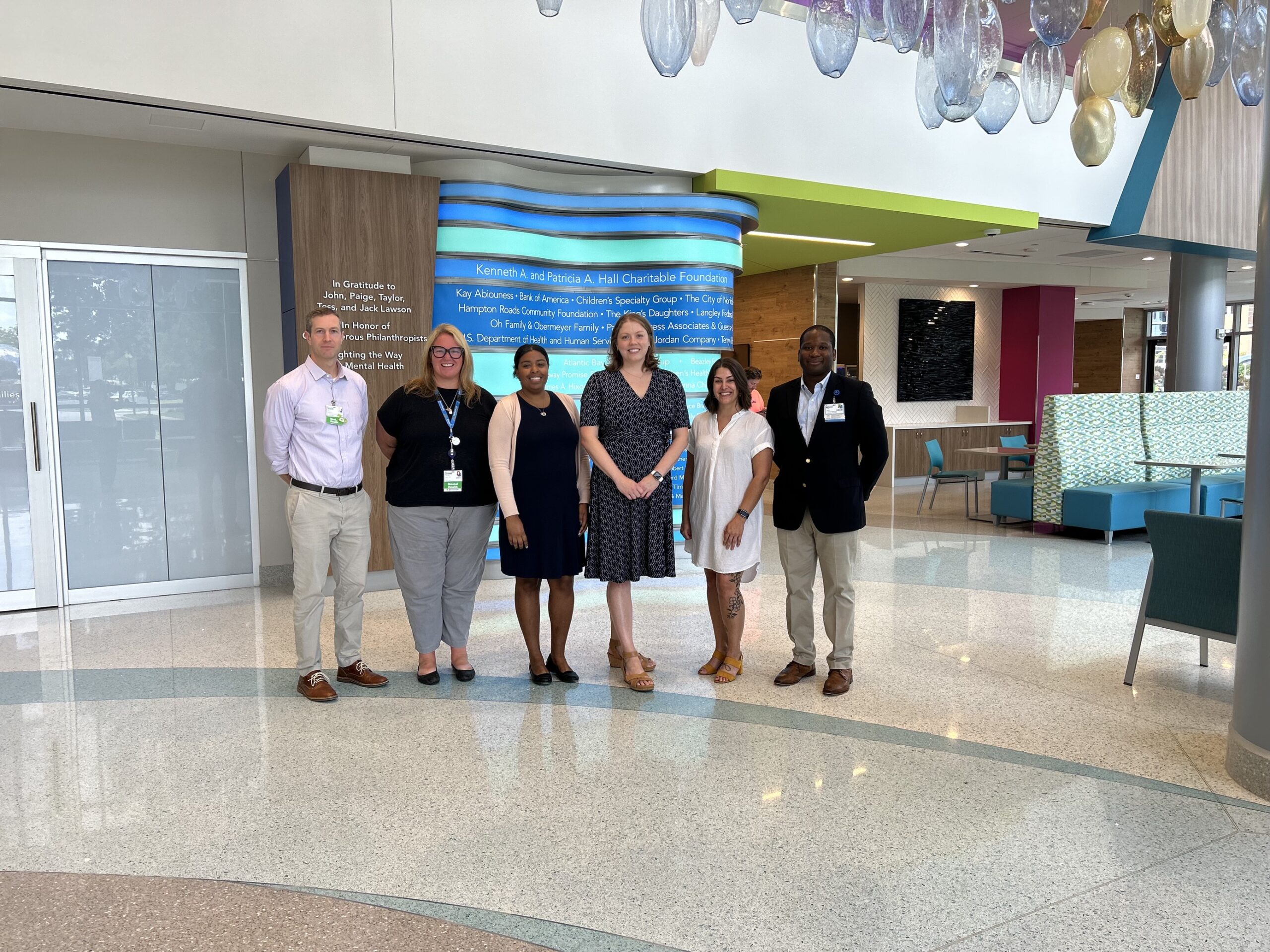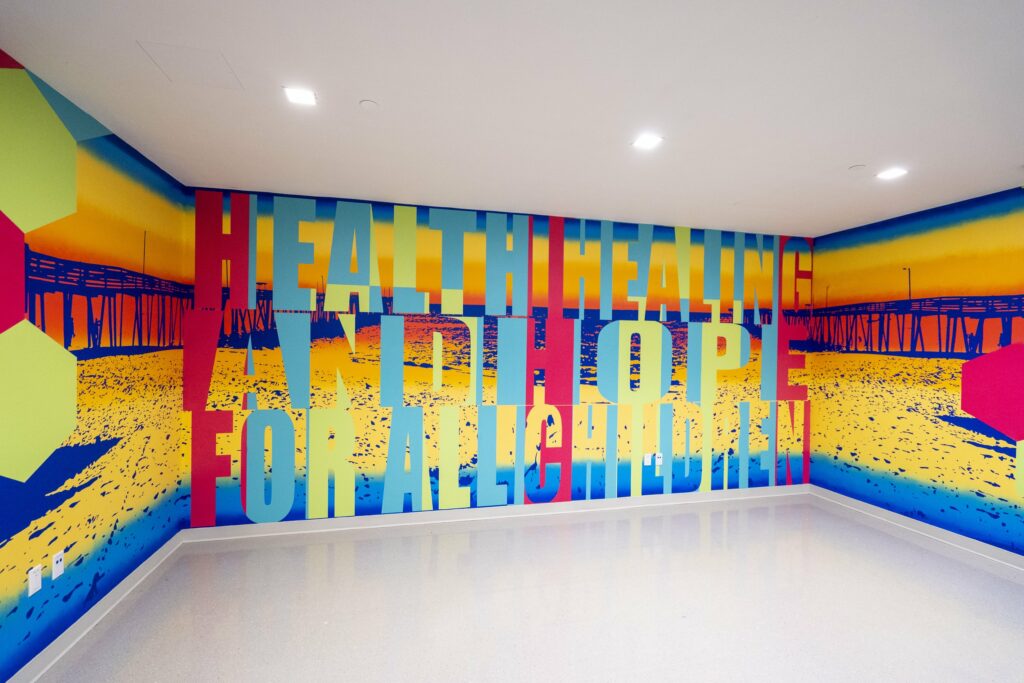

Take a moment to think about the way you would describe an inpatient psychiatric care facility. Do words like “sterile” and “institutional,” and maybe even “uninviting,” come to mind? I think many of us imagine white walls, speckled tile floors, and no natural light. The Voices team was lucky to see a new approach and a different reality last week when we visited the Children’s Pavilion at Children’s Hospital of the King’s Daughters (CHKD) in Norfolk.
The Children’s Pavilion is a holistic wellness checkpoint for young people, offering general pediatrics and sports medicine in addition to inpatient and outpatient mental health services. Housing all these services under one roof supports the integration of mental and physical health care, reducing stigma and ensuring young people get the full breadth of care they need to thrive. Of course, we as professionals were thrilled to see these services available, but the real question was, “How do you make this a place that young people and their families feel comfortable coming to for support?” The answers became abundantly clear as Jack, Stephanie, and Bryant (pictured above) gave us a tour.
From the moment you exit the parking garage, you are met with vibrant colors, comfortable seating options, and an abundance of natural light. As we have noted in a previous blog post, designing physical facilities with young people’s needs in mind is just as critical as the design and implementation of services. So, while we were there to learn about their mental health services, we quickly became interested in the physical, built space and the “why” behind their design choices.

Artwork from Massachusetts artist Joseph Wardell in the garage lobby with CHKD’s mission statement, “Health, Healing and Hope for All Children”
Some highlights of how CHKD’s built environment is trauma-informed, healing-focused, and family friendly are:
When planning for the Children Pavilion’s design and programming, the focus on integrating family members into their child’s care was at the forefront. Stephanie shared with us that visiting hours for family members are very liberal—families don’t have to adhere to the typical 8 am to 8 pm visiting hours that you would see at most hospitals. Instead, the inpatient rooms are private rooms equipped with two beds so that a parent or caregiver can spend the night. We know the importance of engaging families as partners in the mental health treatment of their children, as a young person’s mental health needs do not exist in a silo outside of their family and environment.
We were blown away at the intentionality and care put into providing support to young people at the Children’s Pavilion. And we were also curious about what happened when a young person left the facility and went back home and into their community. What does the follow through and continuum of care look like at a time when mental health services for young people are scarce and providers have long waiting lists? Jack shared that in addition to community partnerships and referrals, CHKD has five locations in surrounding communities to provide outpatient therapy, intensive outpatient care, and partial hospitalization services. Continuity of care is deeply important, so CHKD clinicians and social workers ensure that there is a discharge plan in place and do their best to connect children to community-based support as needed.
But as we are seeing across the Commonwealth, there are still barriers to ensuring all children have access to mental health care in their communities. CHKD is not immune from the challenges we are seeing across the mental health field, including struggling to fill enough positions to have a robust workforce that meets the immense need and navigating reimbursement rates that do not accurately reflect how much it costs to provide care.
As the Virginia Health Care Foundation points out in their Assessment of the Capacity of Virginia’s Licensed Behavioral Health Workforce, we suffer from a severe shortage of child and adolescent psychiatrists and 3.2 million Virginians live in a federally-designated Mental Health Professional Shortage Area. CHKD is fortunate to have been able to hire 17 child and adolescent psychiatrists for the Children’s Pavilion, but they still face barriers with insurance credentialing and reimbursement rates. They acknowledged how restrictive the regulations have been regarding who can provide care and who can get paid for providing the care—for example, there are complicated billing processes for residency and counseling students who are working towards licensure. Voices was proud to share that there was legislation passed during the 2023 General Assembly session (HB 2262) to streamline insurance credentialing and remove administrative barriers to new clinicians getting paid in a timely manner through managed care insurance organizations (MCOs).
Voices’ CEO Rachael shared that this visit was inspiring to her as a professional, but even more so as a parent. At a time when Virginia ranks 48th in the nation for youth mental health, we find hope in the collective efforts to transform the way Virginia provides mental health care to young people. We also know that there is a long road ahead until we have a truly comprehensive continuum of mental health care across the state. This path forward is one that requires investment from our state lawmakers and our localities, and one that allows us to look beyond the current system to reimagine what is possible and create a world where children and youth can thrive.
We have a roadmap to transform our behavioral health system through expanding school-based mental health services, investing in more youth-serving community crisis supports, and supporting the workforce in our Community Services Boards and private providers. We also have a commitment from our Governor and bipartisan support from state lawmakers to invest a historic amount of funding into transforming this system. We are hopeful that we will soon see a final budget that acknowledges the importance of these investments and puts young people’s mental health needs at the forefront. When the investments are made, we look forward to seeing many of these healing elements that we saw firsthand at CHKD be incorporated into the implementation of new and expanded services across the Commonwealth.
Read More Blog Posts